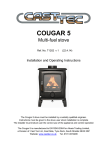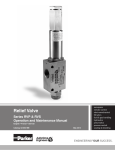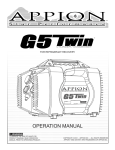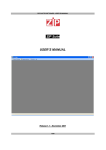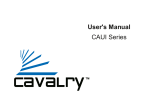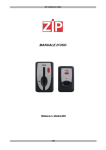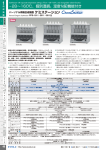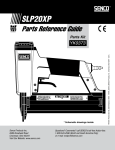Download Euro Kitchen Appliances PS101-30 Operating instructions
Transcript
Glás Non Boiler Insert Installation & Operating Instructions Table of content 1. 2. 3. 4. 5. Page no: Technical data. . . . . . . . . . . . . . . . . . . 1/2 General Information . . . . . . . . . . . . . . . . . 3/6 Installation Instructions. . . . . . . . . . . . . . . . 7/8 Operating Instruction. . . . . . . . . . . . . . . . . 9 Exploded View/ Parts Listing. . . . . . . . . . . . . . . 10 Technical Data: STOVE DIMENSIONS Front View Left View Top View 512 mm 596 mm 396 mm 494 mm 494 mm 186 mm 311 mm 239 mm Firebox Dimensions 398 mm 1 Installation introduction with Technical data Installation of a Pierce Stove must be in according to local codes and regulations in each country. Installers must observe all local regulations, including those which refer to national and European standards when installing the product. All Pierce Stoves are accompanied by Both an installation manual with technical data and a manual on general use and maintenance. Only after a qualified inspector inspects an installation, it can be used. All Pierce Stoves have a name plate of heat -resistant material affixed. Information about identification and documentation for the product is contained on this. Technical data: 1. Material: Cast iron 2. Finish: High-temp, Resistance paint 3. Fuel: Multi-Fuel 4. Log length, max: 30cm 6. Flue outlet: Top rear 7. Flue pipe dimension: 8. Inside: 150 mm/175 cm2 cross section 9. Approx. weight: 74.5kgs TECHNICAL DATA Wood Logs Ancit Total Efficiency % 78.5 75.7 Nominal heat output kW 4.7 5.0 Mean CO emission (at 13 % O2) % 0.28 0.18 Mean flue gas temperature ºC 295 306 Flue gas mass flow g/s 3.6 4.0 Mean CnHm emission Nmg/m3 509 Mean NOx emission Nmg/m3 35 DIN Plus particulates Nmg/m3 35 Technical data according to EN13229 Operational mode: Intermittent Recommended chimney draught: 12 Pa Intermittent combustion in this context means normal use of the fireplace, i.e. fuel is added as soon as the fuel has burnt down. 2 GENERAL INFORMATION: Before installation of your Pierce Stove these instructions should be read carefully to fully understand the controls of your new stove. Keep these instructions for future reference. Due care should be taken when unpacking and installing a Pierce Stove as not to cause damage to your new stove or its surroundings. Check all components are present and functioning before installation occurs. INSTALLATION REQUIREMENTS Installation must always be completed in accordance with current building regulations by a competent qualified person. Incorrectly installed stoves can cause serious accidents such as chimney fires or damage to insulation materials in partition walls and or roofs and ceilings. The installation of the stove to current building regulations is the sole responsibility of the home owner. CHIMNEY REQUIRMENTS Do not install a Pierce Stove into a chimney that serves any other heating appliance. The chimney height must be a minimum of 4.5 meters vertically from the floor on which the stove is installed to the top of the flue terminal in order for the stove to perform satisfactorily. The chimney should not have an excessive cross sectional area and should be in good condition without any cracks or blockages. The advice of an expert should be sought in relation to having the chimney lined, if deemed necessary by an expert a suitable lining for a solid fuel stove must be used. The internal diameter of any chimney or flue liner used must not be less than 125mm. Any flue liner and or adaptors used must be fitted strictly to the manufacturer’s installation instructions. The flue should be checked and swept before connection to the stove. There may be a need to fit a draught stabilizer if an excessive draft exists, advice should be sought from an expert on the draft conditions. The chimney should be swept twice per year, any flue liner used should be cleaned in accordance with manufacturer’s instructions. AIR SUPPLY / VENTILATION When installing a stove it is recommended that a permanent air vent be fitted if not already in position. The vent should have an effective area of 550mm2 per kW of rated output above 5kW. In some instillation conditions under 5kW output stoves will have sufficient air for combustion from natural draughts from doors and windows. In newer properties designed to be almost airtight it may be necessary to have a vent fitted for a stove under 5kW rated output. It is recommended to seek expert advice on the air supply/ventilation for your installation to achieve the best performance from your Pierce Stove. If an air vent is fitted it must not be obstructed for any reason when the stove is in use. An extractor fan should not be fitted in the same room as your stove as fumes may emit into the room. It is recommended to fit a Carbon Monoxide alarm for your safety where you have a stove Installed; this is not mandatory in the republic of Ireland at present but is mandatory in the UK. EXTERNAL SURFACE CLEANING Cleaning on the matt finish stove is recommended with a brush attachment on a vacuum cleaner. Cleaning on an Enamel finish stove is recommended with mild soapy water and a soft cloth. Strong abrasive utensils or strong detergents should never be used, always clean the stove after cooling. 3 DISTANCE TO COMBUSTIBLES Pierce Stove insert stoves operate at high temperatures and are designed for installation into an existing fireplace. For safe operation of your Pierce Stove there are minimum distances to combustible materials, including wood and Plaster board, that must be adhered to at all times. These distances are as follows (see below diagram also) 350mm to either side of the stove 550mm above the stove 550mm from the front of the stove If a combustible mantelpiece hangs further than 100mm from the fireplace front it is necessary to extend the minimum distance above the stove by adding the extra amount to the minimum distance above the stove. For example if a mantle protrudes 150mm, the clearance to the mantle will increase to 600mm. (550mm +50mm) 100 550 350 If the installation is into a recess in a studded wall (timber beams and plasterboard) then the following minimum distances should be observed; 400mm on either side or rear 600mm above the stove The stove should also be installed on a solid non combustible base, this base should extend 350mm from the front of the stove as per above diagram. GLASS CLEANING When there is sufficient heat generated from the fire the air wash system should keep the glass clean. Over time the glass may require cleaning, it is recommended to clean with a liquid detergent and soft cloth taking care not to scratch the glass. 4 CHIMNEY FIRE It is unlikely you will ever experience a chimney fire if your stove is installed and operated correctly as per the operation instructions. In the unlikely event of a chimney fire close the primary air and secondary air controls immediately, evacuate the building and call the Fire Service. Do not re-enter the building until you have been advised by the Fire service that it is safe to do so. Ensure the stove is not used again until the chimney has been swept and the stove, chimney and flue have been inspected by a qualified competent person. IMPORTANT INFORMATION 1. This appliance should not be used as an Incinerator. 2. Non recommended fuels, including liquid fuels should not be used. 3. This appliance, especially surfaces, will be hot to touch when in operation and due care should be taken. It is recommended to use an appropriate fire guard when children the aged or infirm are present. 4. No unauthorized modifications should be made to this appliance. 5. Only recommended replacement parts from the manufacturer should be used for this appliance. 5 FAULT FINDING INSTRUCTIONS Problem Fire difficult to start Probable Cause Wood green, too damp or poor quality Logs are too big Fire goes out Air starvation Insufficient draught Action -Use the recommended fuel. -To light the fire, use small, very dry kindling. To maintain the fire, use split logs. -Open primary air and secondary air -Check that the flue is not obstructed, sweep it if necessary Seek specialist advice. -Ensure that the primary air is closed. Partially close secondary air. -Install a draught stabiliser. -Do not continuously burn small wood or carpentry offcuts. - Too much draught Fire burns too quickly Excessive draw Poor quality wood Insufficient draught Smokes while burning Low heat output Down draught Inadequate ventilation Incorrect fuels -Check that the flue is not obstructed, sweep if necessary. Install an anti-down draught cowl. -Insure there is adequate ventilation from outside -Use the recommended fuel. 6 INSTALLATION INSTRUCTIONS: Step 1 Open the stove door and remove all loose packed parts, ashpan, tools and accessories. Step 2 Disassemble the internal parts in the following order. 1. Fire Fence 2. Left and Right Side Castings 3. Loose Top Baffle 4. Grate (Riddling bar will need to be removed also) 5. Back Wall 6. Grate Support 1. Fire Fence 2. Side Castings 3. Loose Baffle 4. Grate 5. Back wall 6. Grate Support 2. Side castings 3. Loose Baffle 1. Fire Fence 6. Grate support 5. Back Wall 4. Grate Step 3 Remove the stove from the convection chamber (Part18 in parts listing) by removing the 2no M6 fixing bolts under the rear of the grate support. Step 4 Ensure the opening is suitable for fitting the stove by placing the convection chamber into the recess in the fireplace opening to ensure a good fit. Ensure the floor area is level with the hearth and there is no rocking as the insert Stove is screw fixed to the floor. Step 5 If the fit of the convection chamber is good and the base where it is to sit is level with the hearth proceed to fix the convection chamber to the floor with the fixing screw supplied. This will require marking where to drill the hole with the convection chamber in place, removing convection chamber, drilling hole and re inserting the convection chamber into the fireplace recess and fixing it into place with the fixing provided. 7 Step 6 Lift the still disassembled stove into the convection chamber approximately 50mm, lift the front edge to prevent damage to the hearth then slide it gently home to its final position . Step 7 The flue liner can now be fixed to the spigot (part 13 in parts listing) with the fixings provided and sealed according to the manufactures instructions. Step 8 Secure the stove to the convection chamber with the 2no M6 bolts removed in step 3. Before fully tightening push the stove against the fireplace. Step 9 Re assemble the parts removed in step 2 in reverse order. Step 10 Re insert the ashpan under the grate. Allow enough time for any fire cement and or mortar used in the installation to dry out according to the manufactures instructions. Before lighting the stove check; 1. That all the internal parts are reassembled correctly. 2. That the riddling grate, primary air slider and air wash slider are working correctly. 3. That the connection between the stove and the flue liner/Chimney are fully sealed and airtight. A small fire may then be lit to check the installation of the stove. Wait at least 24 hours before running the stove at full output. Please note; When this stove is properly installed it will not emit any fumes into the room. On occasion when using the riddling grate or refueling the stove a small amount of fumes might escape into the room. Constant fume emission is dangerous. If there is persistent fume emission into the room open the windows and doors and let the fire go out. Check the chimney/flue for any blockages and have them cleaned if necessary. Do not relight the stove until the cause of the fume emission has been ascertained and corrected, get expert advice if necessary. OPERATING INSTRUCTIONS: 8 OPERATING INSTRUCTIONS: + - - + PRIMARY AIR CONTROL SLIDER VALVE The primary air control slider is positioned underneath the ashpan door (see diagram above left). This slider controls the intake of primary air underneath the grate, slide to the right to increase the rate of burn and to the left to decrease the rate of burn. This slider should be fully open (to the right) when lighting the stove. When the stove is in use this control can get hot and it is advised to use the glove provided with your stove when adjusting. Primary air is normally used more when burning mineral fuels such as coal. AIR WASH SLIDER The air wash slider control is positioned underneath the door to the top of the stove (see diagram above centre). This slider controls the intake of air wash air into your stove, slide to the right for the maximum amount of air and to the left for the minimum amount of air. Over time you will find the best setting for you installation and type of fuel used. Airwash air is normally used more when burning wood logs. RE-FUELLING/RIDDLING CONTROL The riddling control is positioned to the left just above the ashpan compartment (see diagram above right). Before refueling the stove riddle the fire by connecting the operating tool supplied onto the riddling control and slide the control in and out to release all the dead ash to the ashpan compartment below. When adding more fuel do not over fill the fire box as this can cause damage by over firing the stove, the fuel should not be filled higher than the front fire fence. After fueling close the door and adjust the primary air slider to required setting. Never let the ash pan become over full as this will cause damage to the grate. Be sure to empty the ashpan before lighting the stove. Ensure the ash has cooled completely before removing the ashpan and disposing of the ash. LIGHTING THE STOVE First make sure the inside of the stove has been adequately cleaned and that all dead ash has been removed also ensure the ashpan has been emptied and the ashpan compartment is clear of any dead ash. Open the primary air to its maximum setting. Place some firelighters or papers on the centre of the grate and light, add some kindling as required, as the fire establishes itself add your selected fuel and close the door. Adjust the primary air setting as required. FUELS The stove has been tested using smokeless fuel (Ancit) and wood logs. Other fuels are available and may give similar results. Wood logs up to 30cm long can be used. All fuels should be kept as dry as possible before Use. 9 GLAS INSERT STOVE EXPLODED VIEW 1. Fire Fence PS10120 2. Ash Baffle PS10162 3. Ashpan Door PS10108 4. Fire door PS10107 5. Front Frame PS10103 6. Top Baffle I1141 7. Right Baffle I1113 8. Left Baffle I1112 9. Moving Grate I1115 10. Grate Frame I1114 11. Back Baffle I1111 12. Air Wash Cover I1109 13. Spigot125 (2) 14. Ash Pan HandleCA0105A 15. Hinge A CA1604 Hinge BCA1603 Hinge AxiaCA0614 16. Blanking Plate CA1102-B 17.Holder CAWK0105 18. Convection Chamber CAWK01 19. Axial Fiber 20. Combustion Chamber 21. Handle 22. Fiberglass rope 23. Fiberglass rope 24. Glass slips 25. Door Handle 26. Door Glass 27. Door Catch 28. T Handle 29.Ashpan 30.Wrench 31. Grate control handle 32. Air Wash control 33. Air wash Shutter (down) 34. Logo Badge 35. Door handle axel 36. air wash shutter (up) CAL0103 CANK01 CA0114-083 CA0802 CA0801 CA1112 CA0114-083 CA10-PS101 CA1505 CA0109 CA1218 NLFBS-007 CA0137 CA0104-PS201 CA1114-PS101 CA0101-ZH CA1113-PS101 10 Unit 2 Whitemill Industrial Estate Wexford Co Wexford www.piercestoves.ie Email: [email protected]












